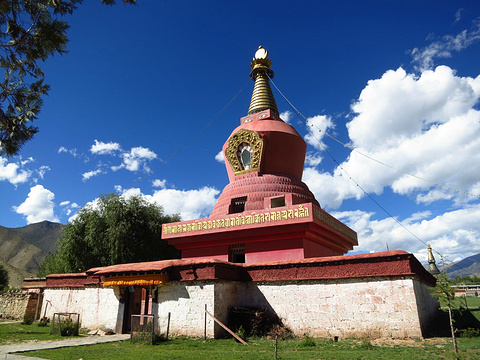Chinese Name: 纳木错湖 Pronunciation: Nà Mù Cuò Hú
Altitude: 4,718 Meters
Suggested Visiting Hours: 1 Day
Lake Tourist Area: 1,920 square kilometers
Opening Hours: All-day (Monday - Sunday, January 1 - December 31)
Address: Located in the middle part of the Tibet Autonomous Region, China.
| Peak Season (May 1st - October 31st) |
Shoulder Season (November 1st - April 30th) |
|
| Adult | 120 yuan | 60 yuan |
| Child (under 1.2m tall) | 0 yuan | 0 yuan |
| Senior (over 70 yrs. old) | 0 yuan | 0 yuan |
1. Children under 1.2m tall are free of charge;
2. Senior citizens over 70 years old (with an ID card or passport) are free of charge;
The sights (Welcome Stone, Gassho Stone, Hole of Good and Evil, Temples, Five islands, and Nagenla) inside the Namtso Lake are free of charge.
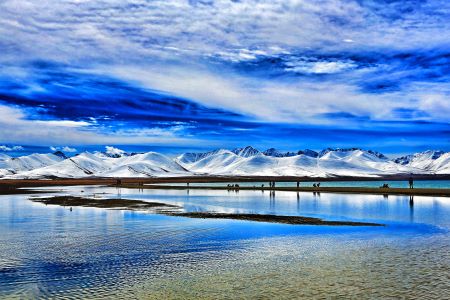
Located in the central part of Tibet Autonomous Region, Namtso Lake is the second largest lake in Tibet and the third largest saltwater lake in China. Namtso Lake is also called Namu Lake or NamtsoLake.
The Lake is 4718 meters above sea level. It is the highest lake in the world. The maximum depth of the water is over 120 meters. The Lake covers an area of about 1920 square kilometers. It is approximately rectangular in shape, more than 70 kilometers long from east to west, and more than 30 kilometers wide from north to south.
Namtso Lake is a famous place for Tibetan Buddhism. In Tibetan, Namtso means “Heavenly Lake”. It is one of the three sacred lakes in Tibet. It is said that Namtso is the Ashram of the Tantric Master and worshipers honor it as one of the four great mighty lakes.
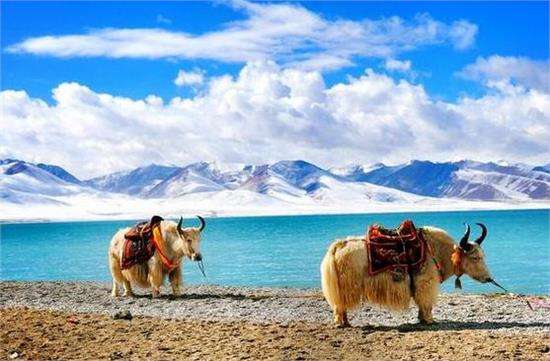
Namtso Lake is a closed lake with low precipitation and strong sunshine. The only way to get water out is through evaporation from the lake. The source of lake water is mainly from natural precipitation and the supply of melting ice and snow from the mountains.
The south and east of the Namtso Lake are the high Gangdise Mountains and the majestic Nyenqing Tangula Mountains respectively. The north of the Namtso Lake is the less undulating hills of the Northern Tibetan Plateau. Nyenqing Tangula Mountain's main peak is straight into the clouds night and day all year round. The plateau is gentle and rolling, and the vast grassland is around the lake. Namtso Lake looks like a huge mirror, inlaid in the grassland of northern Tibet.
Lakeside plain has good pasture, which is a natural pasture. Every early summer, herds of wild ducks come to inhabit and breed. Wild animals such as bear, yak, wild donkey, rock sheep often inhabit around the lake. The lake abounds in scaleless fish and fine scaly fish of the plateau. The lake also produces rare medicinal materials such as cordyceps, Icefollies, and fritillary.
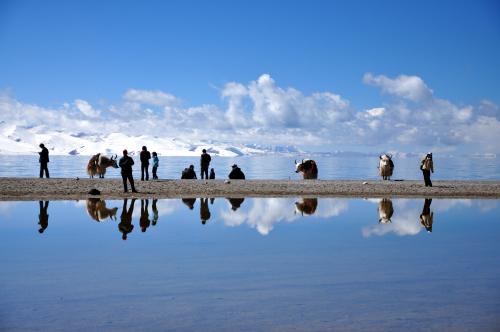
At the end of the 12th century, eminent monks such as Dalongtang and Bazasibe, the founders of the Tibetan Dharong Kagyu Sect, went to the Namtso Lake to practice the Tantric Dharma and began the creation of the Year of the Sheep around the Namtso Lake.
Every year in the Year of the Sheep, it is said by believers that the gathering of the dharma gods, Buddhas and Bodhisattvas, will set up a Dharma Congregation in Namtso Lake. At that time, people went to the lake to pray and chant sutras, which was better than the usual ritual of revolving around the lake to chant sutras 100,000 times.
This blessing is so great that monks and laymen will not hesitate to travel a long way to make the journey to the lake every year of the Tibetan calendar.
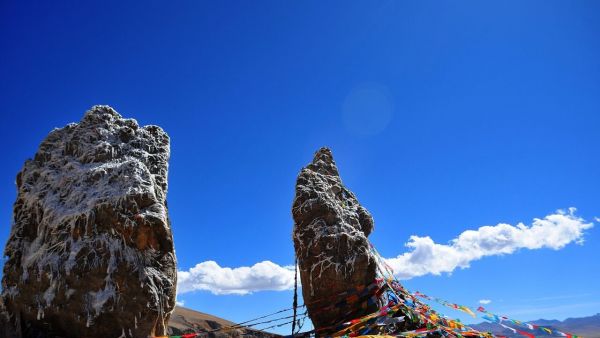
Located on the Tashi Peninsula, Welcome Stone is known as the God of Door of Namtso Lake and between the two pillars is the Heavenly Gate.
The two huge pillars among which one is tall and the other is short. The high one is perfectly integrated, and the low one has a gap about one person wide in the middle. It's just a Yin and a Yang. Therefore, Welcome Stone is also called Couple Stone.
It is said that Namtso is a goddess, who is in charge of the wealth of the grassland in northern Tibet. When traders go out to do business, they must first come here and pray to the God of Door. They can worship Namtso with the permission of the Door God to ensure the prosperity of their business.
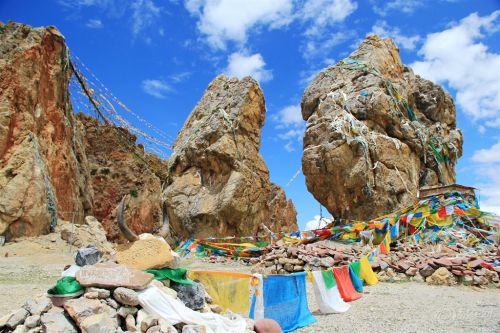
The Gassho Stone beside Namtso Lake is also called Parent Stone.
It is said that it is the incarnation of the father Nyenqing Tangula Mountain and the mother Namtso goddess, symbolizing their faithful love. This palm is for Lotus Master, the founder of the Zhichunan Nyingma Sect, to clasp hands and pray for the manifestation of all things.
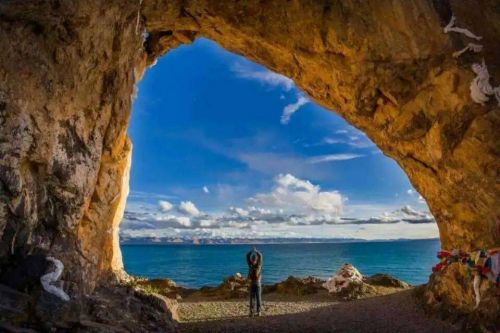
According to Tibetan Buddhism, heaven is sure to know whether a person is doing good or evil. The Hole of Good and Evil is just a wake-up call from the Buddha. No matter what you look like, as long as you have a good character, you can walk through the hole. Otherwise, you should reflect on your mistakes.
The shape of Namtso Lake is like the Mother of Golden Stiffness. There are 18 beams on the south side of the lake, such as tortoise beam and peacock beam, and 18 islands on the north side of the lake, such as Huangya Island and Pengniao Island.
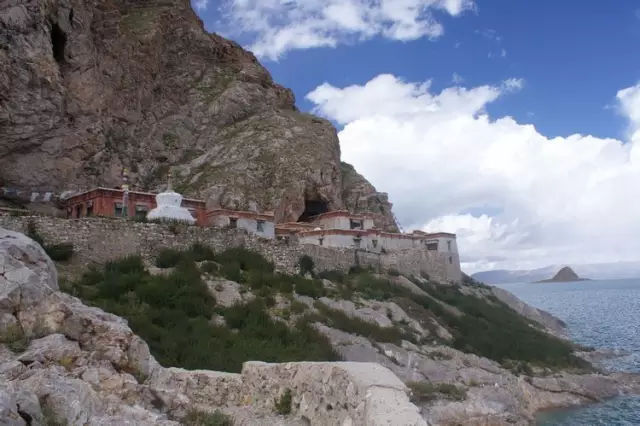
There are also four temples on the four sides of the lake, symbolizing the Buddhist words of wrath, anger, power and force. That is Doboche Temple in the east, Gurqiong Pema Temple in the north, Doga Temple in the west and Chateau Temple in the north.
There are many naturally formed Buddha statues on the walls of these temples. It is said that Namtso is Indra's daughter and the Nyenching Tangula’s mother. Namtso is considered a sacred place that all the men and women must go to. Therefore, there are many pilgrims in these temples from ancient times to the present.
Tashi Temple, located on the Tashi Peninsula, is a famous sacred Buddhist site. Every year during the Year of the Sheep in Tibet, thousands of Buddhists come here to make a pilgrimage. Usually, they would walk clockwise along the lake to get the blessing of the gods.
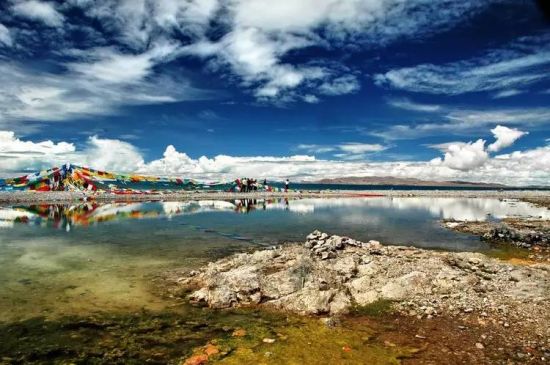
The five islands in the lake stand out in the blue waves. Buddhists say that they are the incarnations of the Five Buddhas. Five peninsulas jut out into the water from different directions, among which the Tashi Peninsula is the crown of the five. The Liangduo Islands is the largest one with an area of 1.2 square kilometers.
On the Tashi Peninsula, there are a great many bizarre stone peaks. Some of them are like trunks; some look like human beings; some resemble trees. In addition, many quiet grottoes can be found on the Tashi Peninsula and they are masterpieces of nature.
Some grottoes are long and narrow, like subways and some are full of stalactites, while the others are like shutters. The unique rocks, steep peaks, natural stone staircases and other landform wonders of Tashi Peninsula present tourists with a picture full of mystery and charm. It is also a common tourists’ favorite. It takes about two hours to circle the island clockwise.
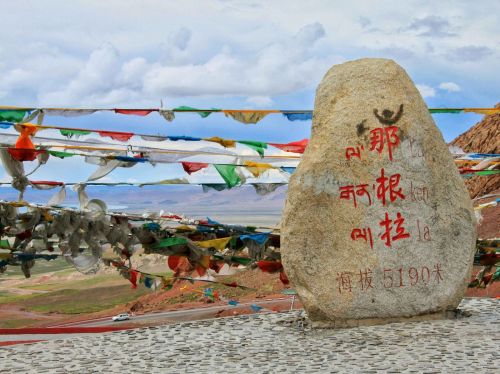
Nagenla is also called Nagenla Mountain Pass. Located in Dangxiong County, Lhasa City, Tibet Autonomous Region, the Nagenla is 5,190 meters above sea level. It is the only way to Namtso Lake and a sacred place in the hearts of Tibetans.
Nagenla Pass is a mountain passage from Nyenqing Tangula Mountains to Namtso Lake, which belongs to the so-called forbidden zone of life with an altitude of more than 5000 meters. You can see Namtso Lake from here. It is a scenic spot and a rest point.
In the hearts of all the Tibetan people, each mountain pass is a sacred place. Therefore, Prayer Flags are hung on the Mani Pile at the pass to show reverence for the gods. A stone monument marking the altitude standing here.
The temperature at the Nagenla Pass is particularly low. People travelling to Namtso Lake should bring their own down jacket. Overlooking Namtso Lake from the pass, the beautiful holy lake is like a mirror embedded in the sky. Standing in the mountain pass, overlooking the wild, your heart will immediately surge up the feeling of the vast and powerful.
It is said that in ancient times, Nyainqen Tanggula and Namtso were a match made in heaven. Nyainqen Tanggula is the "Lingying Grassland God", and the most authoritative among the northern gods. Namtso is the daughter of Di Shitian (a god). According to the legend, Nyainqen Tanggula rode a white horse with armor fitted on his head, a whip in his right hand, and a rosary in his left hand. Namtso rode on a flying dragon, holding a dragon-shaped Zen stick in her right hand and a Buddha mirror in her left hand. They are a very loving couple who live together in the northern part of the Tibetan plateau and they make a living by herding.
A poignant love story of this loving couple starts from a snowstorm. As Nyainqen Tanggula and Namtso forgot to sacrifice to the Dongming God, the God waved long sleeves, and thousands of miles are covered with snow overnight, while the wind was rages. The tent of the couple Nyainqen Tanggula and Namtso looked like drunk people who sway in the wind and snow, and the fence of the livestock fell apart under the attack of the strong wind. The frightened animals ran to the snowfield with the neighing. In an instant, the livestock looked like a massive black vanquished army running around on the snowy plain.
When Nyainqen Tanggula untied the thick curtain of the door, the strong wind with the snow dashed into the tent directly. Nyainqen Tanggula tried to keep out the wind and snow with one hand and held the torch lit with the other. But the wind and snow hit the torch, and the flame soon went out.
Reluctantly, Nyainqen Tanggula tightened the curtain again, standing in the dark tent, listening to Namtso's sobbing cry, seemingly thinking about something. The neighing of the livestock went further and further through the storm. Nyainqen Tanggula put the torch at the door and sat next to Namtso in the dark. Then, Nyainqen Tanggula held Namtso in his arms and held her tightly. They were like two lovers who depended on each other for warmth in the middle of winter.
Nyainqen Tanggula promised to Namtso: "the grassland belongs to you and me. No matter where the livestock goes, I can get them back. When the Sun God shows up tomorrow, it is the beginning of our parting. When you see a herd coming in the distance, it is my return time. " Namtso laid in his arms, closed her eyes, and felt the endless enthusiasm in Nyainqen Tanggula's chest. Namtso felt that Nyainqen Tanggula’s bones were like solid steel, and tenderness flowing in muscles and blood. At this moment, although the snowstorm was still raging out their tents, her heart was in the secret garden of only two people.
The Sun God drove away the night. But the Sun God did not want to get involved in this private resentment. He hung his bright light on the sky to illuminate the earth but did not give warmth to the world.
The cold of the night had frozen the earth ten feet deep. Namtso packed her husband's luggage and proposed a toast to Nyainqen Tanggula before his leaving. She said, "my husband, whether you find livestock or not, you should return home like an arrow." Nyainqen Tanggula lifted his wife's wind-blown hair on her forehead and put it behind her ears. He kissed her forehead, took the burden from his wife's arms, turned, and walked quickly to the wild where the wind was roaring, and the snow was heavy.
Namtso stared at his husband’s tall figure until he disappeared completely in the vast snow. She could not help crying. Tears trickled down her beautiful cheeks, melting miles of snow in the middle of winter, turning into streams that still flow into Namtso Lake today.
The blizzard lasted for forty-nine days, and none of the creatures on the grassland were spared and died under the wrath of Dongming God. Nyainqen Tanggula walked in the blizzard for 49 days and found his frozen livestock bodies every day. On the 49th day, he found the last group of yaks. Nyainqen Tanggula, who had suffered from the loss of livestock, drew his sword to heaven and asked Dongming God, "since you want sacrifices, why don't you question me face to face why I didn't offer sacrifices? Since you want to punish me, why do you harm the world? To be a man and a god is ashamed of heaven and earth! Now, I will let you pay for your blood.” Dongming God sneered, and they fought between heaven and earth.
In this fight, the sky was split, the earth quaked, and mountains moved. They fought for three days and three nights, and Nyainqen Tanggula was defeated because of the long journey, cold, and hunger. Dongming God pushed Nyainqen Tanggula down from the top of Naiqin Kangsang Mountain, thinking that he must have died. On this day, the beautiful girl Yamdrok saw a bright star falling from the sky. Thinking that it was not an ordinary thing, she led the hound to follow the star and came to the foot of Naiqin Kangsang Mountain. Arriving at the foot of the mountain, she did not find the star in her guess. She saw a handsome man lying in a pool of blood, unconscious.
The kind-hearted Yamdrok took Nyainqin Tanggula home on her back, put on clean clothes for him, and bandaged his wounds. Nyainqen Tanggula slept deeply for another 49 days. These days, Yamdrok had been guarding him. She set up a fire for him in cold weather and wiped the sweat from his forehead in his dreams. As time went by, Yamdrok regarded him as her dream lover.
After Nyainqen Tanggula woke up, his memory had disappeared. At the moment when he opened his eyes, he saw a beautiful girl sitting beside him, inquiring after his needs, slaughtering sheep, and cooking for him to celebrate his recovery. At this time, Nyainqen Tanggula had no memory of Namtso and fell in love with that girl at first sight. In the spring, they married and lived on the grassland for 500 years as herdsmen. Their laughter turned into flowers all over the mountains, and their love lit up the stars in the sky.
Until one day, Nyainqen Tanggula grazed at the foot of Naiqin Kangsang Mountain, looked up at the top of the mountain, and remembered that Yamdrok said he was her star from Naiqin Kangsang Mountain. Although Nyainqen Tanggula had no surname and was called husband by Yamdrok, he was incredibly happy. However, he wanted to know his past. Then he climbed up Naiqin Kangsang Mountain and looked down at everything at the foot of the mountain.
A lake as blue as a gem touched his heart in the distance, and he thought he had known it before. He also saw the cliff cut by a huge ax and a tidal-like picture flooded in his mind. This cliff was caused when he fought with Dongming God. He remembered all things gradually. Facing the wind, he looked tearfully at the lake, which used to be his home. Namtso's appearance occupied his mind, and his yearning for Namtso flowed like a river. He ran down the mountain and told Yamdrok about his past. He told her that he wanted to leave her to find Namtso. Yamdrok, sitting at his feet, held his long sleeve with tears to let him not go.
Nyainqen Tanggula turned around abruptly, pulled out his sleeve to mount his horse, and ran straight to Namtso, regardless of Yamdrok’s heart-breaking appeal. After three days and three nights, Nyainqen Tanggula came to Namtso and found that Namtso had melted herself into tears, turned herself into a spoony lake, and told him that she had suffered from five hundred years of waiting and missing. Nyainqen Tanggula fell to the ground, turning himself into a towering mountain, holding the pure Namtso. He vowed to protect her until the end of time.
Namtso Lake is located between Dangxiong County in Lhasa and Bange County in Nagqu District. There are two routes to Namtso Lake, the north route and the south road.
Drive 230 kilometers west from Nagqu Town → reach the north shore of the Namtso Lake
Dangxiong County → Nyenching Tangula Mountains → Nagenla Pass → Tashi Peninsula → Namtso Lake
(Note: You should revolve around the Tashi Peninsula several times in odd numbers; the Tibetan custom is to revolve Tashi Peninsula 13 times.)
July to September is the best season for visiting Namtso Lake. But the road conditions are poor because of much rain at this season.
As for the accommodation, you can spend a night on the lake with friends and see Namtso Lake at dawn and dusk. There are mud huts for accommodation, which can accommodate up to nine people. You can also stay at local Tibetan settlements. Several houses are available for lodging on the Tashi Peninsula without running water or electricity at night and all the rooms add up to a maximum of forty people. If you can't rent a room, you have to set up a tent in the open air. It's better to arrive early in the peak season and rent a room as soon as possible.
As for the food, you can have authentic Tibetan yogurt in the morning. Namtso Lake is a saltwater lake, but the water is not particularly salty and can be drunk by burning or filtering it.
As for moving around the Namtso Lake, you have to make good preparation. Firstly, you must adapt ourselves to the plateau in Lhasa. Then you have to get water and other supplies ready. Yak horses for loading things on their backs should be ordered in advance in Bange County. Revolve around the lake on foot for 7 to 10 days depending on physical strength. It will take one to two days to drive around the lake and be led by a local guide familiar with the road conditions.
There are no long-distance buses from Lhasa to Namtso Lake, so travelers are required to rent a car with them.
Chinese: 请带我到纳木错湖。English: Please take me to the Namtso Lake.
If you take the chartered vehicle from Lhasa to the Namtso Lake, you will cost from 1200 to 1800 yuan, depending on the travel season and your bargaining ability. ( Time spent depends on travel season.)
If you take the chartered vehicle from Lhasa to the Namtso Lake in peak season, it will cost around 1,700 yuan. (Time spent depends on travel season.)
If you take the chartered domestic jeep from the Dangxiong County to the Namtso Lake, you can't save much money and will waste a lot of time to find the car and there is few cars in the Dangxiong County and the condition of the car is poor in Lhasa. (Time spent depends on travel season.)
